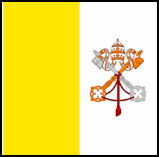Vatican
 The State of Vatican City is an area of 109 acres within the City of Rome. The Pope of the Roman Catholic Church is the spiritual sovereign of this city-state. The Holy See, a component of the Roman Catholic Church heirarchy, is the territorial sovereign or government of that state. In that sovereign capacity, the Holy See occupies a recognized position in international law and, accordingly, conducts diplomatic relations with more than 80 foreign countries and sends representatives to various international organizations, including the United Nations.
The State of Vatican City is an area of 109 acres within the City of Rome. The Pope of the Roman Catholic Church is the spiritual sovereign of this city-state. The Holy See, a component of the Roman Catholic Church heirarchy, is the territorial sovereign or government of that state. In that sovereign capacity, the Holy See occupies a recognized position in international law and, accordingly, conducts diplomatic relations with more than 80 foreign countries and sends representatives to various international organizations, including the United Nations.
The United States first established consular relations with the Holy See in 1797. In 1848, it formalized the two governments' relationship and, from 1848 to 1867, sent four official emissaries, all confirmed by the Senate, to serve there. Formal diplomatic relations between the United States and the Holy See were severed in 1867, and the two governments did not exchange any further representatives until 1939, when President Roosevelt and Pope Pius XII informally reestablished relations. Over the next forty years, various Presidents appointed personal envoys to the Holy See. In 1984, after Congress cleared the path by way of legislation , President Reagan exchanged formal diplomatic notes with the Holy See and nominated William A. Wilson to be the United States' Ambassador to that government.
Popes in their secular role ruled portions of the Italian peninsula for more than a thousand years until the mid 19th century, when many of the Papal States were seized by the newly united Kingdom of Italy. In 1870, the pope's holdings were further circumscribed when Rome itself was annexed. Disputes between a series of "prisoner" popes and Italy were resolved in 1929 by three Lateran Treaties, which established the independent state of Vatican City and granted Roman Catholicism special status in Italy. In 1984, a concordat between the Holy See and Italy modified certain of the earlier treaty provisions, including the primacy of Roman Catholicism as the Italian state religion.
The state of Vatican City is the smallest sovereign state in the world. A tiny enclave within the city of Rome, it occupies 109 acres and is almost completely surrounded by medieval walls. As a result of the Lateran Pacts of 1929, the Italian Government granted St. Peter's Basilica and Square and the surrounding area within the Vatican walls as the Holy See's sovereign and independent territorial base. Besides St. Peter's, Vatican City also includes the Apostolic Palace, administrative and residential buildings, museums, archives, and libraries, a cemetery, and gardens covering almost one-third of the entire area. Thirteen other buildings in Rome, as well as the Pope's summer residence at nearby Castel Gandolfo, enjoy extraterritoriality under the terms of the Lateran Pacts.
Vatican City is the physical base of the Holy See, the central government of the Roman Catholic Church. The word "See," in Italian "sede," literally means a seat, as a bishop's seat or diocese, in this case that of Peter and his successors, the popes. The Pope exercises supreme spiritual authority over the worldwide Roman Catholic Church and supreme legislative, executive, and judicial authority over the Curia Romana and the State of Vatican City. The Pope governs through the Curia Romana, the Holy See bureaucracy that was reorganized in the June 1988 reform.
Rome now is one of the grandest cities in the world. Millions of pilgrims and tourists come every year to admire, and be awed by, its treasures of architecture, art, and history. But is was not always this way. By the fourteenth century, the great ancient city had dwindled to a miserable village. Perhaps 20,000 people clung to the ruins despite the ravages of disease and robber barons. Popes and cardinals had fled to Avignon in southern France. Rome was dwarfed in wealth and power by the great commercial cities and territorial states farther north, from Florence to Venice.
In the Renaissance, however, the popes returned to the See of Saint Peter. Popes and cardinals straightened streets, raised bridges across the Tiber, provided hospitals, fountains, and new churches for the public and splendid palaces and gardens for themselves. They drew on all the riches of Renaissance art and architecture to adorn the urban fabric, which they saw as a tangible proof of the power and glory of the church. And they attracted pilgrims from all of Christian Europe, whose alms and living expenses made the city rich once more.
>The papal curia -- the central administration of the church- -became one of the most efficient governments in Europe. Michelangelo and Raphael, Castiglione and Cellini, Giuliano da Sangallo and Domenico Fontana lived and worked in Rome. Architecture, painting, music, and literature flourished. Papal efforts to make Rome the center of a normal Renaissance state, one which could wield military as well as spiritual power, eventually failed, but Rome remained a center of creativity in art and thought until deep into the seventeenth century.
|
NEWSLETTER
|
| Join the GlobalSecurity.org mailing list |
|
|
|

